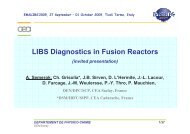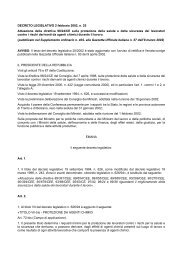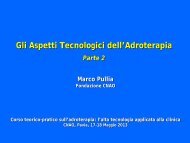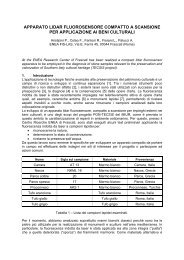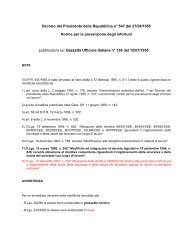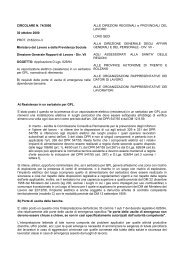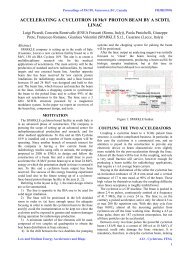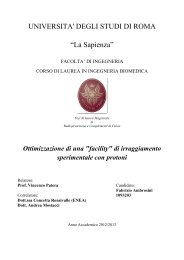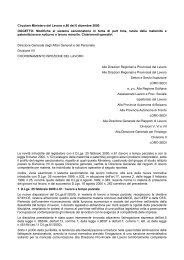Theory, Design and Tests on a Prototype Module of a Compact ...
Theory, Design and Tests on a Prototype Module of a Compact ...
Theory, Design and Tests on a Prototype Module of a Compact ...
You also want an ePaper? Increase the reach of your titles
YUMPU automatically turns print PDFs into web optimized ePapers that Google loves.
2 1. INTRODUCTION TO THE HADRONTHERAPY<br />
may be the <strong>on</strong>ly effective treatment, sometimes in c<strong>on</strong>juncti<strong>on</strong> with<br />
surgery.<br />
It may not be possible to irradiate some lesi<strong>on</strong>s with these c<strong>on</strong>venti<strong>on</strong>al<br />
beams or to remove them surgically because <strong>of</strong> the proximity <strong>of</strong><br />
critical tissues <str<strong>on</strong>g>and</str<strong>on</strong>g> prot<strong>on</strong> therapy may be the <strong>on</strong>ly possible form <strong>of</strong><br />
treatment.<br />
If neutr<strong>on</strong> or prot<strong>on</strong> beams are not available the alternatives are<br />
very expensive chr<strong>on</strong>ic medical care or treatment at overseas centers.<br />
Radiati<strong>on</strong> therapy machines are expensive, high technology equipment,<br />
but the advantages are<br />
• A sterile envir<strong>on</strong>ment is not required.<br />
• Few people are involved in patient treatment, which does not<br />
necessarily require the daily presence <strong>of</strong> a Radiati<strong>on</strong> Oncologist<br />
or any other clinician.<br />
• Most patients are treated as out-patients <str<strong>on</strong>g>and</str<strong>on</strong>g> therefore do not<br />
occupy scarce <str<strong>on</strong>g>and</str<strong>on</strong>g> expensive hospital beds.<br />
• Irradiati<strong>on</strong> is not traumatic for patients, who are not anaesthetized<br />
<str<strong>on</strong>g>and</str<strong>on</strong>g> usually do not get sick from the treatment.<br />
Radiati<strong>on</strong> therapy is therefore cost-effective <str<strong>on</strong>g>and</str<strong>on</strong>g> <strong>of</strong>ten cheaper than the<br />
alternatives <strong>of</strong> surgery, chemotherapy <str<strong>on</strong>g>and</str<strong>on</strong>g> chr<strong>on</strong>ic health care.<br />
Neutr<strong>on</strong>s <str<strong>on</strong>g>and</str<strong>on</strong>g> prot<strong>on</strong>s are both nuclear particles <strong>of</strong> approximately<br />
the same mass. However, the fact that neutr<strong>on</strong>s are uncharged <str<strong>on</strong>g>and</str<strong>on</strong>g><br />
prot<strong>on</strong>s are charged particles results in their having vastly different<br />
physical properties <str<strong>on</strong>g>and</str<strong>on</strong>g> biological effects. Using c<strong>on</strong>venti<strong>on</strong>al phot<strong>on</strong><br />
radiati<strong>on</strong> as the st<str<strong>on</strong>g>and</str<strong>on</strong>g>ard, the dose distributi<strong>on</strong>s <strong>of</strong> fast neutr<strong>on</strong>s are<br />
very similar, but their biological effects <strong>of</strong>fer advantages for the treatment<br />
<strong>of</strong> certain types <strong>of</strong> tumours, while the advantages <strong>of</strong> prot<strong>on</strong>s lie<br />
in their physical dose distributi<strong>on</strong>s.<br />
Many large tumours have central cores, which lack oxygen because<br />
the blood supply has been reduced by the proliferating tumour cells.<br />
Other tumours are slow-growing <str<strong>on</strong>g>and</str<strong>on</strong>g> the cells spend a relatively short<br />
time in the dividing phase <strong>of</strong> the cell cycle, where they are most sensitive<br />
to radiati<strong>on</strong>. These tumours are resistant to c<strong>on</strong>venti<strong>on</strong>al phot<strong>on</strong><br />
radiati<strong>on</strong> but are far less resistant to neutr<strong>on</strong> irradiati<strong>on</strong>, which therefore<br />
in principle has a better chance <strong>of</strong> effecting a cure. Examples <strong>of</strong><br />
tumours that are effectively treated by neutr<strong>on</strong>s include salivary gl<str<strong>on</strong>g>and</str<strong>on</strong>g><br />
tumours, large breast tumours <str<strong>on</strong>g>and</str<strong>on</strong>g> certain tumours <strong>of</strong> other s<strong>of</strong>t tissues.<br />
However, because radiati<strong>on</strong> causes damage to the normal tissue<br />
in fr<strong>on</strong>t <strong>of</strong> a deep-seated tumour, a so-called isocentric beam delivery<br />
system (<strong>on</strong>e which rotates about the patient) is essential so that the patient<br />
can be irradiated from several different angles. This c<strong>on</strong>centrates<br />
the dose at the tumour <str<strong>on</strong>g>and</str<strong>on</strong>g> limits the dose to normal tissue.<br />
High energy prot<strong>on</strong>s are particularly suitable for treating cancer<br />
or other (benign) abnormalities near sensitive structures such as the<br />
optic nerve, spinal cord, kidneys, etc., where other forms <strong>of</strong> radiati<strong>on</strong>





